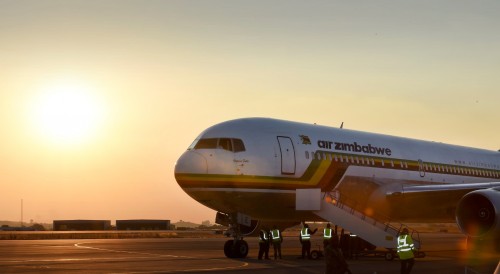AirZim board promises to turn around airline
THE new Air Zimbabwe board has come up with various strategies to ensure that the Air Zimbabwe Strategic Turn-Around Business Model becomes a reality by aggressively pursuing joint venture relationships with all key SADC airlines and also promoting trans-border air travel.
Recently, President Mnangagwa approved the appointment of six people to be substantive board members of Air Zimbabwe, taking over from an interim board that was appointed about a year ago.
The six are Dr Silvanos Gwarinda, the chairperson of the board, who is a very versatile and hands-on air transport professional with close to 40 years working experience in key strategic positions in marketing/sales development, commercial planning, bilateral air services negotiations, route network development, tourism, and aviation consultancy and tourism and academic industries.
He holds a PhD in Air Transport and Tourism Management from the University of Westminster, London, UK.
The others are deputy chairperson of the board Ms Ruth Raina Hungwe-Rukarwa, Mr Edmund Murambiwa Makona, Mr Lawrence Simbarashe Musendekwa, Mr Ticharwa Garabga and Ms Mucharemba Kahombe.
The seventh board member, a woman, will be appointed soon.
Transport and Infrastructural Development Minister Felix Mhona announced the appointments on Monday.
Speaking on behalf of the board, Dr Gwarinda said they had great optimism about the future of Air Zimbabwe, despite the existing challenges.
He said there was potential for growth for Air Zimbabwe due to the geographical location of Zimbabwe.
“We have a huge potential as a country due to our strategic and geographic central location within the Sadc Air Travel Market,” said Dr Gwarinda. “This promotes Harare as an attractive and natural hub for flight connectivity from within the Sadc market and beyond.
“This positions Air Zimbabwe as an ideal candidate to implement an effective hub-andspoke air operational strategy.
“Zimbabwe is a long-haul tourist destination vis-à-vis our major source markets such as
Europe, Australasia, and the USA. Air Zimbabwe thus plays a very critical role in the
development and growth of our international tourism.
“We have a mammoth task in front of us. And we truly believe that this task is
surmountable – if we all work together as a team. Our strength is going to be as good as
our weakest link.
“We can assure you, Honourable Minister, that we will leave no stone unturned until we
get the winning formula for Air Zimbabwe’s Turn-Around Business Plan. Looking beyond
COVID-19, there is a very positive and active resumption of air travel – both domestic
and international.”
Dr Gwarinda said they will work closely with the Civil Aviation Authority of Zimbabwe in
terms of their Domestic Air Travel Expansion Programme.
“You recall Air Zimbabwe used to fly to such places as Kariba, Hwange National Park,
Masvingo, Buffalo Range, and even to Grand Reef in the Eastern Highlands where we
have the beautiful Vumba Mountains, Mtarazi Falls, and Osbone Dam,” he said.
“Equally, Air Zimbabwe will have to be an active participant in Zimbabwe Tourism
Authority’s aggressive tourism, marketing, and promotional campaigns that are meant
to place Zimbabwe back on the World Tourism Map.
“Air Zimbabwe should be able to enjoy a substantial amount of this air travel market
share. Zimbabwe is our home base. We cannot be seen to be playing second fiddle to other
players in the development of Zimbabwe’s global air access.”
Dr Gwarinda said other key performance areas that will define their success were to reactivate their IATA Membership and to pass their IATA Operational Safety Audit (IOSA) – for Air Zimbabwe to freely fly within the global air space.
“We also have the air assets, eight aircraft in total (B.777 x 2, B.767 x 2, B.737 x 3, and
EMB-145 x 1), but we have lost a number of pilots to the global airlines and a number of
these aircraft are also not serviceable,” he said.
“Utilisation levels of our air assets are also below comparable benchmarks. Due to the
perishability of the airline product, the seat, more will have to be done by Air Zimbabwe
in order to achieve reasonable seat factors for operational viability.”
Aircraft utilisation levels are extremely low, there is reliance on operating short sectors
only and low passenger load factors are being achieved, said Dr Gwarinda.
“This is a recipe for disaster in the aviation world. Why? Your aircraft unit costs per hour
and per seat will be increased substantially,” he said. “This will result in very high and
unsustainable break-even load factors. As per your guidance, Honourable Minister
(Mhona), we are going to work extremely hard to reverse such a trend.
“There is no congruency in the current route network when compared to all the eight
aircraft on our books. You may recall we used to fly to London, Frankfurt, Dubai, China,
and the whole of the SADC, including Nairobi and Dar es Salaam – to name just a few of
the old international destinations.
“We have to get Air Zimbabwe back on the world map. There is a huge gap in the
provision of air cargo capacity between Zimbabwe and our trading partners. This is an
opportunity that Air Zimbabwe will have to seriously consider when they work on their
Fleet Development Plan.”
Dr Gwarinda said the price for the Jet A1 Fuel continues to rise and will thus have a
negative impact on their cost-containment initiatives taking into consideration the age
of the current fleet.
He said they will soon be offering an improved airport experience via their natural
regional hub, the Robert Gabriel Mugabe International Airport, because of the massive
infrastructure development works that are taking place there.-The Herald











